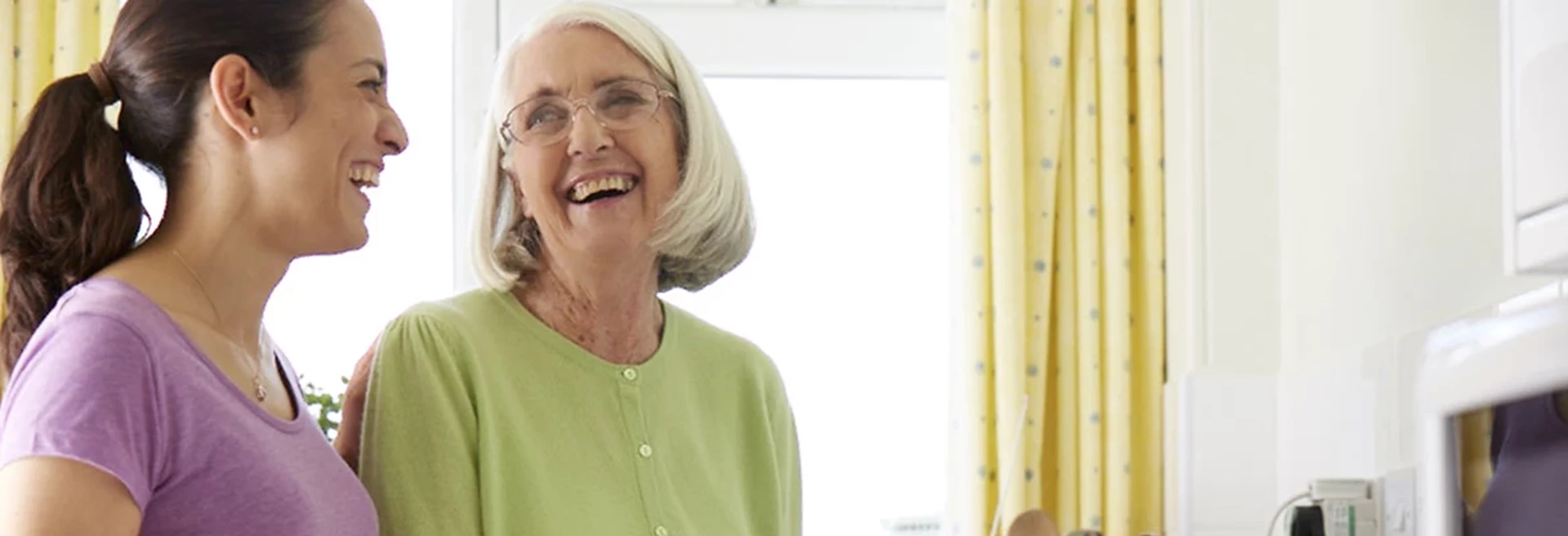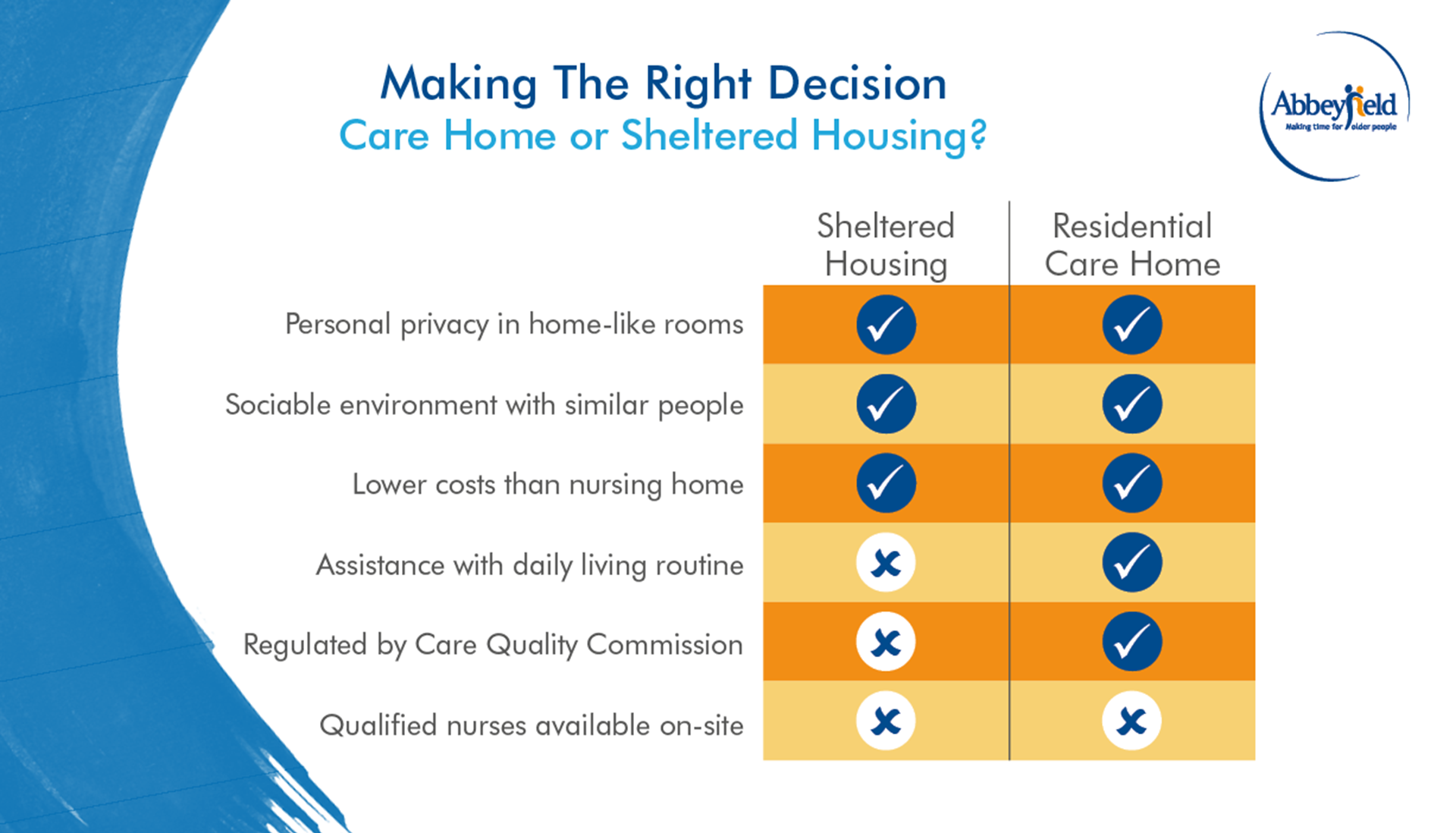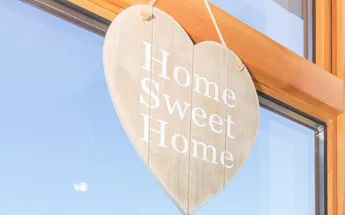At Abbeyfield, as one of the UK’s longest serving providers of retirement housing, we often hear that people looking for accommodation as they get older don’t always understand the difference between a care home and sheltered housing.
It’s understandable though, as there are some similarities like the security of private rooms, the safety of support staff and a sociable environment with activities and home-cooked meals.
As a quick comparison, living in a residential care home are people who need assistance with personal care needs like washing and dressing whereas sheltered housing is for more independent older people who can do these things for themselves but would prefer the company of others and a little support. However, there are key differences to help make the right decision when moving that we’ll explain more about in our guide to Abbeyfield’s retirement housing options in 2019.
In this guide
- What do residents value most in retirement living?
- The similarities between residential care homes and sheltered housing
- The differences between residential care homes and sheltered housing
- Which type of retirement housing is right for you?
What do residents value most in retirement living?
Moving into a new home environment in later life, like a residential care home or sheltered housing (often referred to as ‘sheltered accommodation’), can be a difficult time for the person moving and for the wider family too.
That’s why our helpful Abbeyfield housing support team try their best to make the whole process as smooth as possible, making sure you or your loved one has the most appropriate level of support to respectfully suit personal needs.
According to a study by the National Housing Federation & JRF.org.uk, around 5% of the older population are living in retirement housing in the UK. In this joint study, they’ve conducted research and developed a well-being framework of values that older people with support needs prioritise in their lives to inform a better quality of life.
So before we get into the key comparisons, we’ve compiled a list of the positive contributing factors that, in general, older people value most when moving from their own residence into sheltered housing or a residential care home.
Mental well-being of residents
- Having an own front door to enjoy privacy, controlled entry, and are able to invite guests to their own home-like space.
- Residents having a sense of independence being able to do more for themselves with the right amount of support from staff if needs be.
- To participate in decision making about their own personal needs, especially those who require care, and key decisions about the home.
Physical well-being of residents
- The security of a housing complex that’s often warden controlled is of paramount importance to residents, especially with high levels of fear of crime experienced by older people living alone in the community.
- A mixture of similarly aged residents with similar housing needs rather than in the wider community will overcome fears like break-ins, noise and anti-social behaviour.
- A safe living environment is highly valued by older people with support needs. By having the reassurance of qualified support staff, that it’s easily accessible and adapted for easy movement, contributes to positive physical well-being.
Social well-being of residents
- Nearly half of the sample studied in the report felt that contact with family and existing friends had improved since moving into sheltered housing or a residential care home.
- In the sample, 75% of residents agreed that their retirement housing was ‘a good place to make new friends’.
- Many respondents referred to the importance of having social or voluntary activities to “keep busy” – to stop them worrying, feeling alone, or dwelling on the past.
When searching for the best care home for you or a loved one, make sure as many of the contributing values to a better quality of life are matched by the housing provider. We’re proud to say that in our Abbeyfield homes, we meet all of the reported well-being criteria.

The similarities between residential care homes and sheltered housing
To help make the right decision on retirement housing, before we highlight the key differences, we thought it’d be helpful to list the similarities that these two different older persons’ housing options offer potential residents.
1. Personal privacy in a home-like studio flat or room
A private, homely environment is of paramount importance to someone who needs support in later life. Having the control of your own privacy in a home-like studio flat or room attends greatly to this need in both a care home and in sheltered housing.
2. Sociable environment with similar people
If family don’t live close by or if loved ones or friends have passed away, later life can become lonely. That’s why at Abbeyfield, we have communal environments in our homes and encourage companionship through sharing meals together in the dining area and through participation in regular activities held by our staff or volunteers.
3. No on-site qualified nursing care
One key point to mention is that residential care homes and sheltered housing are different to nursing homes, in so much that they don’t have registered nursing staff on duty to deal with any medical conditions (mental or physical). If physical nursing is required, district nurses are called in. Residential care homes do have staff in attendance around the clock to help with other personal care needs.
For specialist condition homes, visit Abbeyfield’s dementia care housing options.
4. Lower costs than a nursing home
Without any registered nursing staff on duty, the cost of living in a residential care home or sheltered housing is lower than it would typically be in a nursing home. It’s worth noting that each resident will have their needs assessed prior to moving into an Abbeyfield home.
The differences between residential care homes and sheltered housing
Now onto the two key differences between the two housing options; which should help make it clearer to inform the best decision to suit the personal needs of you or your loved one.
1. Care homes assist with daily living routines
We understand that the once simply-handled personal care routines can become more difficult in later life. So one of the key benefits of living in a residential care home rather than sheltered housing is the opportunity to have support with daily living routines, following a personal care plan, to include:
- Washing and dressing
- Going to the toilet
- Eating regular meals
- Medication reminders
- Mobility issues
2. Sheltered housing isn’t inspected by the CQC
Unlike residential care homes, sheltered housing establishments aren’t registered care homes, so they don’t fall under the Care Quality Commission’s (England’s independent regulator of health & social care) remit of services to inspect, therefore don’t need to adhere to their level of CQC inspection criteria.
With that being said, there is supplementary CQC guidance for sheltered living schemes and you can rest assured that all of Abbeyfield’s homes are managed to the highest standards, regulated by the Government’s Homes & Communities Agency.
Which type of retirement housing is right for you?
For a visual comparison between the two types of care that we’ve explained in this guide, view our Care Home or Sheltered Housing Comparison Infographic that’s available to share with family members or download and print to refer to it easily when searching for a new home.

Next steps
What type of care do I need?
If you think you, or someone you know, needs care, the first step is to get a care needs assessment from your local council. We've put together a guide on the care needs assessment process, how to prepare and what happens after you've had an assessment.
When is the right time to move into a care home?
Arranging care at home or moving into residential care or sheltered living can be a complex process, but we’re here to help. We’ll take you through paying for care, step by step.
Housing options for older people
If you’re thinking about where you might like to move as you get older we can help. We've listed some housing options for older people for you to explore and find out the difference between each.


